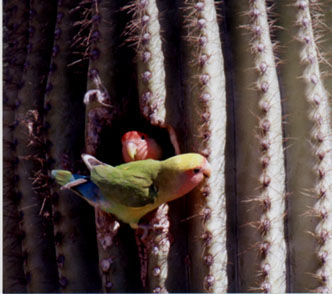Photo by Carla Kishinami (CC BY-NC-ND)
Editor's note: The following article originally appeared in the Maricopa Audubon newsletter as "Peach-faced Lovebirds - Are They Here to Stay?". Numerous sightings have been made of these birds all over the Phoenix area. While it's doubtful that they're a "countable" species as an escaped exotic, this article is being included in the "Arizona Special Species" series because of the expansion of the lovebirds throughout the metropolitan region.
Peach-faced Lovebirds exploring saguaro cavity, Scottsdale, 28 February 1998.
Photo by Greg Clark. ©1998, Greg Clark
For years I have seen and heard escaped caged birds in the greater Phoenix area. Sometimes it was simply a Budgerigar or a Cockatiel that would squawk or chatter as it flew over my head. But in late 1997, one and later up to six, Peach-faced Lovebirds began to make regular rounds to my office complex. They especially liked the palm and bottlebrush tree in the middle of the central courtyard. Then in early 1998, I started to receive calls from curious people that wanted to know what these little green birds were that were coming to their feeders or eating the apples in their backyard tree. All the descriptions were primarily the same: a small (6 inches) bright green bird with a short pointed tail; a mostly rose-pink forehead, cheek, throat and upper breast; small white eye-ring; small, horn-colored, hooked bill; and a baby-blue rump.
I received reports from Phoenix, Carefree, Cave Creek, Tempe, Mesa, Scottsdale, and Paradise Valley. I even had a report from Roosevelt Lake and I saw one in a palm tree at the small town of Palo Verde (west of Buckeye). On 28 February 1998, Greg Clark took the accompanying photographs of a pair of lovebirds investigating a saguaro cavity in a Scottsdale yard.
The more I mentioned the lovebirds to people, the more I discovered that some neighborhoods have had them for years. It is interesting to note that most of the Phoenix area Arizona Breeding Bird Atlas blocks were surveyed from 1993-1996. This species was not reported on any of them. Could it be that they were much more local in distribution only a few years ago? I now frequently hear their shrill, metallic shrieks as they fly over in small flocks in many parts of the city. Dr. Mark Hostetler initiated the Central Arizona - Phoenix Long-Term Ecological Research Project a year or so ago and is also finding this species to be widespread, with reports from Apache Junction, Phoenix, and numerous localities in Tempe.
Far too frequently, exotic parrots and other caged birds escape or are illegally liberated. Most species do not survive for very long. However, in some urban settings, especially in southern Florida, California, and Texas, some species successfully rear young. These states have many similarities such as typically mild temperatures year round, many exotic trees and shrubs, and tropical or Mediterranean climate. Well, Phoenix has mild temperatures year round and many exotic plants too, but the climate is much more dry. Many people think of parrots as tropical; however, Peach-faced Lovebirds are from a very dry region in southwestern Africa. This could be one reason that this exotic species is apparently doing very well here, but has not really been reported as a breeding species in any of these other states.
In Africa, Peach-faced Lovebirds inhabit dry mountainous country, open savannas, and palm groves near water. The species is highly gregarious, usually observed in small flocks, but flocks of hundreds may congregate at a rich food source. Foods include seeds, berries, fruits, and grain. Peach-faced Lovebirds are said to do considerable damage to grain crops when these are planted within their range. They often nest colonially in crevices in cliffs or buildings or in old weavers' nests. In captivity, they build a cup-shaped nest in a "nesting box" made of strips of bark, grass, or leaves that are carried by the female tucked under her rump feathers. Incubation lasts approximately 23 days and the young leave the nest around 43 days after hatching.
Information needed!
So, how can you help? I would like to compile all observations of free-flying lovebirds in the greater Phoenix area. I am hoping this information will help us see how widespread and abundant this exotic species really is. Reports should include the date of observation, location of observation (main cross streets), and how many were observed. Observations of breeding behavior (copulation, courtship, investigation of a cavity, fledglings, etc.) would also be very important information. The few nesting reports I have heard about, have all been from saguaro cavities. Also, if you have knowledge as to how long they have been at that locality, that would be great information.
Email reports to Kurt Radamaker at Arizona Field Ornithologists: KurtRad AT att.net


